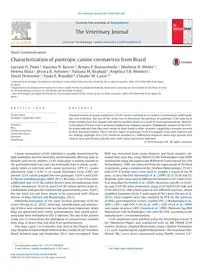
2014 Characterization of pantropic canine coronavirus from Brazil PDF
Preview 2014 Characterization of pantropic canine coronavirus from Brazil
Short Communication Characterization of pantropic canine coronavirus from Brazil Luciane D. Pinto a, Iracema N. Barros b, Renata F. Budaszewski a, Matheus N. Weber a, Helena Mata a, Jéssica R. Antunes a, Fabiana M. Boabaid c, Angélica T.B. Wouters c, David Driemeier c, Paulo E. Brandão b, Cláudio W. Canal a,* a Laboratório de Virologia, Faculdade de Veterinária, Universidade Federal do Rio Grande do Sul, Av. Bento Gonçalves, 9090, CEP 91540-000, Porto Alegre, RS, Brazil b Departamento de Medicina Veterinária Preventiva e Saúde Animal, Faculdade de Medicina Veterinária e Zootecnia da Universidade de São Paulo, Av. Prof. Dr. Orlando Marques de Paiva, 87, CEP 05508-270, São Paulo, SP, Brazil c Setor de Patologia, Faculdade de Veterinária, Universidade Federal do Rio Grande do Sul, Av. Bento Gonçalves, 9090, CEP 91540-000, Porto Alegre, RS, Brazil A R T I C L E I N F O Article history: Accepted 7 September 2014 Keywords: Dog Canine coronavirus Canine parvovirus Pantropic Sequencing A B S T R A C T Characterization of canine coronavirus (CCoV) strains currently in circulation is essential for understand- ing viral evolution. The aim of this study was to determine the presence of pantropic CCoV type IIa in tissue samples from five puppies that died in Southern Brazil as a result of severe gastroenteritis. Reverse- transcriptase PCR was used to generate amplicons for sequence analysis. Phylogenetic analysis of the CCoV- IIa strains indicated that they were similar to those found in other countries, suggesting a common ancestor of these Brazilian isolates. This is the first report of pantropic CCoV-II in puppies from Latin America and our findings highlight that CCoV should be included as a differential diagnosis when dogs present with clinical signs and lesions typically seen with canine parvovirus infection. © 2014 Elsevier Ltd. All rights reserved. Canine coronavirus (CCoV) infection is usually characterized by high morbidity and low mortality, predominantly affecting dogs in kennels and rescue shelters. CCoV replication is mainly limited to the gastrointestinal tract and can eventually lead to death, partic- ularly when co-infection with canine parvovirus (CPV-2), canine adenovirus type 1 (CAV-1) or canine distemper virus (CDV) are present. CCoV can be grouped into two genotypes: CCoV-I and CCoV- II (Decaro and Buonavoglia, 2008, 2011). Recently, CCoV-II has been subdivided into CCoV-IIa (which derives from recombination with a feline coronavirus; FCoV-II) and CCoV-IIb (which derives from re- combination with porcine transmissible gastroenteritis virus; TGEV), but the latter has not been shown to be associated with clinical disease in dogs (Decaro and Buonavoglia, 2011). Following emergence of the more virulent pantropic CCoV-IIa strain (Decaro et al., 2012), detection, identification and monitor- ing of these new coronaviruses has become more important, when dogs are presented with severe gastroenteritis that would previ- ously have been attributed to CPV-2 infection. The aim of the present study was to characterize the phylogeny of coronaviruses isolated from dogs in Brazil that had died from gastroenteritis. Five dogs (aged 1 to 6 months) that died at the Clinical Veteri- nary Hospital of Universidade Federal do Rio Grande do Sul, Southern Brazil, between June and September 2011, were necropsied. Total RNA was extracted from tissue biopsies and fecal samples, ob- tained from each dog, using TRIzol LS (Life Technologies) and cDNA synthesized using the Superscript III Reverse Transcriptase Kit (Life Technologies). DNA was extracted from the supernatant of the fecal suspension, using a commercial kit (Simbios Biotecnologia). CCoV-I and CCoV-II primer pairs were used to amplify a region of the M gene, as described by Herrewegh et al. (1998). EL1F, EL1R and S5, S6 primer pairs were used to differentiate between CCoV-I and CCoV- II as described by Pratelli et al. (2004). Reactions specific to CCoV- IIa and CCoV-IIb were performed, using CCoV-IIaF/CCoV-IIaR and CCoV-IIbF/CCoV-IIbR primer pairs in two different reactions, which amplified fragments of the 5′ end region of the S gene (Decaro et al., 2012). Fecal samples were also analyzed by PCR for the presence of other gastrointestinal viruses, namely CPV-2 (Buonavoglia et al., 2001), CAV-1 and CAV-2 (Hu et al., 2001), CDV (Frisk et al., 1999) and canine rotavirus (CRV) (Gouvea et al., 1990). Platinum Taq DNA Polymerase (Life Technologies) was used for PCR, according to the manufacturer’s recommendations. CCoV amplicons were purified using the NucleoSpin Extract II Kit (Macherey-Nagel) and sequenced with an ABI PRISM 3100 Genetic Analyzer (Applied Biosystems) using a BigDye Terminator v.3.1 cycle sequencing kit (Applied Biosystems). The maximum like- lihood (ML) trees were constructed using PhyML version 3.0.1 * Corresponding author. Tel.: +55 513 308 6926. E-mail address:
